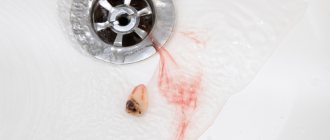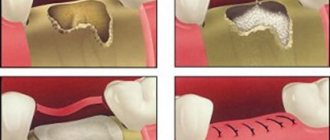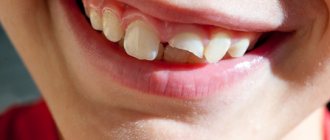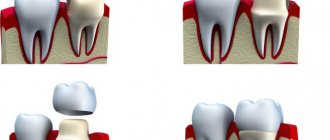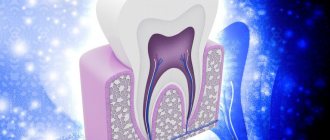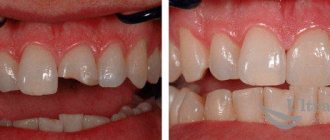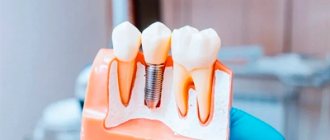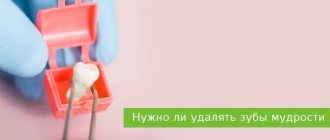The loss of a front tooth is very acute. And this is not surprising. Even if there is a slight darkening of the enamel on the front incisors, the person already begins to feel uncomfortable - he is embarrassed to talk and smile. And the absence of even one tooth along the smile line only aggravates psychological discomfort. Therefore, such problems need to be solved as quickly as possible.
Prosthetics for anterior teeth
are primarily aimed at high aesthetics. Therefore, they use materials that effectively combine strength and high aesthetic characteristics. The Ilatan Clinic in Moscow uses various methods for restoring front teeth using advanced technologies and the latest generation materials. Treatment methods and cost depend on the clinical picture.
Problems arising from missing teeth
The absence of even one dental unit in a row leads to serious consequences:
- Due to the lack of lateral support, neighboring teeth begin to shift;
- if a tooth is lost along with the root, the bone tissue in this area begins to quickly atrophy and decrease;
- chewing function is impaired, which leads to problems with the gastrointestinal tract;
- the bite changes, which leads to deformation of the position of the jaw joint and dysfunction of the umbilical nervous system;
- The shape of the face changes, the upper lip begins to recede, and wrinkles appear.
The longer a tooth is missing, the more severe the consequences will be. If a tooth is lost in the smile area, patients are offered different options for restoring the dentition. The method depends on the clinical picture.
How tooth loss affects facial contours
Loss of teeth, especially complete ones, immediately affects a person’s appearance. Firstly, the height of the lower third of the face decreases due to the fact that the support of the lower jaw by the teeth is lost and the jaw moves back in the joint area, and forward and upward in the chin area.
The result is a so-called “senile face” - the distance between the tip of the nose and the top of the chin decreases. Due to this, the natural folds of the face deepen, the corners of the mouth droop, the red border of the lips decreases in width due to their displacement towards the oral cavity.
Losing teeth causes a decrease in the tone of facial muscles, the cheeks and chin tissues sag. Visually, the face looks more mature. Dental restoration sets the lower jaw in the correct position, provides support to soft tissues, and restores the smile. As a result, facial rejuvenation occurs, patients feel confident, and their quality of life improves significantly.
These changes are also possible with partial loss of teeth.
Especially in the case of chewing teeth. I have patients (women) who turned to a cosmetologist with a desire to improve their facial contours and eliminate sagging cheeks. In response to this, the doctor strongly recommends that the missing chewing teeth be restored first to provide soft tissue support and only then begins his own procedures. Because only in this case we get the most complete and long-lasting effect.
Aesthetic restoration of anterior teeth
If you need to correct the appearance and shape of incisors or fangs, the best solution is ultra-thin veneers or lumineers. Plates 0.2 - 0.3 mm thick made of ceramic or zirconium are fixed to the outside of the teeth, eliminating all visual defects, making the smile luxurious. Such microprostheses do not require significant intervention in the structure of the teeth. The enamel is prepared exactly to the thickness of the plate, and the veneers are fixed to the surface of the teeth using a special glue (bond). Typically, veneers are installed on 6-10 upper and 4-6 lower teeth along the smile line.
Reason 1 – digestive problems
The digestion process begins in the mouth, when crushed and chewed foods are moistened with saliva containing certain enzymes. As a result, a formed and pre-processed food bolus enters the stomach. In the absence of chewing teeth, food is not crushed enough and is poorly saturated with saliva. As a result, stomach cells have to produce more hydrochloric acid, which increases the risk of developing gastritis.
The inability to chew food thoroughly leads to a change in diet. A person who does not know whether to insert teeth is trying to adapt to existing defects; he tries to eat more soft, pureed or liquid foods. This contributes to dystrophy of the oral mucosa, dysfunction of the digestive glands, decreased peristalsis, and changes in the microbial composition of the intestine.
If the front tooth is destroyed, but the root is preserved
In case of significant destruction of the coronal part (up to 50%), the front tooth can be restored using prosthetic crown. The affected tooth is depulped, followed by filling the canals, given the desired shape (prepared), if necessary, the root is strengthened with a stump insert. The crown is fixed onto the prepared stump using dental cement.
For the smile area, it is better to choose all-ceramic or metal-free crowns made of zirconium or aluminum oxide. These materials have a shade and degree of transparency similar to natural enamel. The doctor will select an option so that the restored tooth does not stand out in any way in the general row.
Reason 5 – aesthetic side
If a person refuses to insert the front lower or upper teeth, then the cosmetic defect will be significantly pronounced. In addition to visual changes, speech also suffers, the pronunciation of certain sounds is disrupted, and in some cases the patient’s appearance also changes. Since the dentition is a support for the soft tissues of the face, when this support disappears, sagging or sunken cheeks appear, facial features change, and asymmetry appears. All this leads to psychological problems, self-doubt, isolation, and fear of appearing in public. The longer the defect exists, the more pronounced these problems become.
With complete absence of a tooth
Prosthetics for front teeth in the absence of them involves 2 main methods:
- Installation of a bridge prosthesis
- this method is suitable for replacing 1 to 4 missing incisors. A bridge is a structure of several connected crowns, 1-2 suspended in the center and 2 hollow on the sides, which are attached to adjacent supporting teeth. The main disadvantage of the method is the need to grind and often depulpate the supporting units, even if they are completely healthy. That is, if you need to restore 1 missing incisor, two adjacent ones will have to be injured. - Implant prosthetics
– technology allows you to restore any number of missing teeth in a row. An implant is implanted into the jawbone, which fully replaces the missing tooth root. After the implant has healed, an adapter (abutment) is installed on it, onto which an artificial crown is fixed, identical in shape and color to the natural tooth. If an entire segment of the dentition is missing (3 or more teeth), 2 artificial roots are implanted, onto which a bridge is fixed. - Prosthetics of the front tooth immediately after extraction
is performed using the express implantation method. Immediately after surgical removal of a tooth, an implant is screwed into its socket, an abutment and a temporary crown made of lightweight plastic are fixed onto it. The temporary crown is removed from the bite, does not take part in chewing, it is necessary only to preserve the aesthetics of the smile. After 2-3 months, when the implant has fused with the bone, the temporary prosthesis will be replaced with a permanent one made of durable, reliable material (metal-ceramics, zirconium, etc.).
Prosthetics on implants does not involve injury to neighboring units; implanted implants perform all the functions of a natural tooth root and prevent jawbone atrophy. Implants are implanted once and for all; only prosthetic structures are subject to replacement (if they break or end their service life).
What can lead to tooth loss
Tooth loss begins with periodontal disease.
The first cause of adentia is periodontitis.
The second reason for tooth loss is caries.
The next cause of tooth loss is pulpitis
Other causes of tooth loss include periodontitis and hypoplasia.
Another reason for the development of edentia is diabetes mellitus.
If tooth extraction was previously carried out in a patient with diabetes, then it is necessary to understand that diabetes in general accelerates the atrophy of tissues, bones, and all degenerative processes in the body: from vascular sclerosis to trophism of the limbs. And in this case, it also affects edentia.
Look at the example of one of the patients with insulin-dependent diabetes mellitus, how he developed atrophy. Of course, this does not happen instantly, over several years, but edentia is an inevitable fact, unfortunately:
The professional experience of the specialists of the German Implantology Center allows us to successfully solve even such, sometimes very complex problems associated with atrophy and edentia by performing bone grafting and sinus lifting with subsequent implantation:
This clinical case and its successful treatment are reviewed in more detail - HERE
That is, there are two main reasons for tooth loss:
The first is periodontal disease (periodontitis), the second is caries and its complications (pulpitis and periodontitis), hypoplasia.
There are other reasons, but they are, let’s say, quite exotic and “don’t make a difference.” At the moment, there is no consensus on why caries and periodontitis occur and how to prevent them.
There are many theories, but there is no single answer to the question of how to prevent the development of these diseases. In my opinion, this suggests that these are multifactorial processes that involve genetics, nutrition, hygiene, the nature of the area in which a person lives, and so on and so forth... Why am I saying this? And to the fact that the reasons for development are a separate topic for discussion and we will return to it later, but now let’s look at the consequences of tooth loss.
Where can you put your teeth?
Where to put the teeth? Implantation and prosthetics services in Moscow are offered by a large number of dental clinics. However, it is important to choose the right dentistry, where your treatment and dental restoration will be carried out at a high level of quality.
Always find out the reputation of the clinic before contacting it and remember that low prices for implantation and prosthetics are often not a reason for joy, but rather a reason to be wary and check all the information on dentistry even more carefully. High-quality dentures, crowns, implants cannot cost a penny!
If you want to have your teeth treated with prosthetics and implantation, we invite you to visit our modern dental clinic in Moscow - “VENSTOM”. We are ready to offer each of our patients: comfortable conditions for treatment, an individual approach, and high quality of all procedures performed.
With us you can have teeth placed using any of the technologies discussed in the article. Qualified specialists from our clinic will help you choose the optimal dental restoration technique for you! You can get an initial consultation on dental treatment at VENSTOM free of charge!
The cost of restoring a smile
The cost of prosthetics depends on what type of prosthetics was used, what materials were used, whether additional manipulations were necessary - treatment, root removal. So, for example, prices for metal-ceramic crowns start from 7,000 rubles, ceramic ones - from 20 thousand, zirconium dioxide - from 25 thousand rubles. Installing an implant will cost at least another 20-30 thousand. Temporary orthopedic structures cost from 2,000 rubles.
1Goldstein R. Aesthetic dentistry, 2003.
Your questions and answers
QUESTION Hello, my front side tooth is broken. And it broke almost at the root. From the outside it is very noticeable. What is the best way to “fix” it? Or just delete, and there are no other options? Vladislav K.
ANSWER Hello, Vladislav. If the root of a broken tooth is healthy, then it may well serve as a support for a prosthesis. But you can find out more about this at a face-to-face appointment with a dentist, because... you need to take an x-ray and see “what’s inside.” Further, as for the “repair” - prosthetics, you can install a crown (preferably ceramic) supported by a pin or stump inlay. But even if the dentist insists on removal, do not rush to install a regular bridge, because... it will require the use of 2 healthy teeth at the edges. You will have to grind them down and remove the “nerve” - this will reduce the service life of the supporting teeth. Plus they will be overloaded. Therefore, if removal cannot be avoided, then the ideal option is an implant with a crown on top.
Author: Chorny S.V. (Thank you for your help in writing the article and the information provided)
Features of frontal prostheses
If the front tooth has significant damage to the vestibular surface that cannot be restored with filling materials, an excellent solution is ceramic onlays or lumineers. These dental products are so thin that even when applied to an unprepared tooth, they practically do not distort its dimensions, but the front surface acquires a natural appearance without losing the smooth transition of color from dark, in the gum area, to a slightly lighter incisal edge. Lumineers are an excellent alternative to completely replacing a tooth with an artificial prosthesis, since such frontal petal overlays are highly colorfast and do not require special care.
Another option for prosthetics is used when removing one front tooth, in the place of which is most often a lateral incisor or first premolar (dentists call it a “four”). The essence of the method is that a strip of material similar to fiberglass is glued to the back surface of the dentition units adjacent to the defective tooth, and if such a strip is impregnated with a special composite filling material, it becomes rigid and strong, so that an artificial tooth can be glued to it .
In addition, if one front tooth is lost, a small removable denture can be made, placed on the gum and held by the adjacent teeth using special devices - clasps. These structures can be either metal or less noticeable - plastic, although in this case the clasps are not attached to the teeth, but are applied to the gums and are called pelots.
Conclusion: possibilities for prosthetics of the anterior row of teeth without grinding the adjacent ones exist, they have their own objective advantages and minimal disadvantages, but in order not to rack your brains over the choice of prosthetic design, it is much better to avoid losing teeth at all, and especially the front ones.
What to do with a knocked out tooth?
A “lost piece” that has fallen into snow, mud or autumn slush can only be rinsed with water, but cannot be scraped and cleaned “to a mirror shine” so as not to damage the still living fibers. For the same reasons, you should pick up the tooth by the crown, and not by the root, which will be re-engrafted into the hole. Disinfection of living tissue with alcohol or hydrogen peroxide is also prohibited.
After dislocation, the tooth should be kept in a moist environment, which will significantly increase its chances of replantation and healing. How to achieve this?
- The best natural medium that supports the vitality of a lost tooth is saliva. Therefore, the tooth can be placed in the mouth, on the opposite side from the damaged side, tucked between the cheek and gum. When a baby tooth is dislocated, a child may scream and cry. To prevent the tooth from being swallowed, its transportation can be handled by an accompanying relative—preferably the mother.
- Perhaps the adult victim or those around him have a container for storing contact lenses. The tooth can be placed in the saline solution it contains.
- A small container filled with water or milk will also work.
- If there is a pharmacy in the neighborhood, you can buy any drug that represents a physiological environment - glucose, 0.02 percent furatsilin, novocaine, etc.
First actions
If the tooth left its natural “habitat” unharmed, and you managed to find it, then you can count on the restoration of the unit. Find a small container, pour saline solution and place the tooth there. If you don’t have the necessary items on hand, you can wrap the unit in regular cloth or cotton wool. If possible, place a special cold pack next to the unit; it can be purchased at a pharmacy. In extreme cases, use ice.
If there is no heavy bleeding, it is enough to treat the oral cavity with any antiseptic liquid, Miramistin or Chlorhexidine will do. If there is severe pain, take any painkiller tablet, for example, Nise or Ketarol.
In case of heavy bleeding, you should immediately visit a doctor or call an ambulance.
Pros and cons of temporary solutions
The advantages of temporary orthopedic structures are as follows:
- fast production,
- quite good aesthetics at first,
- low cost.
The disadvantages include, first of all, not very reliable fixation - even non-removable temporary ones can come off and fall out while chewing food. The disadvantages include low strength and rapid loss of aesthetics. Since the surface of plastic and composite materials is porous, food deposits, pigments, and microbes settle on it - and it is impossible to bleach the product to its original appearance.


